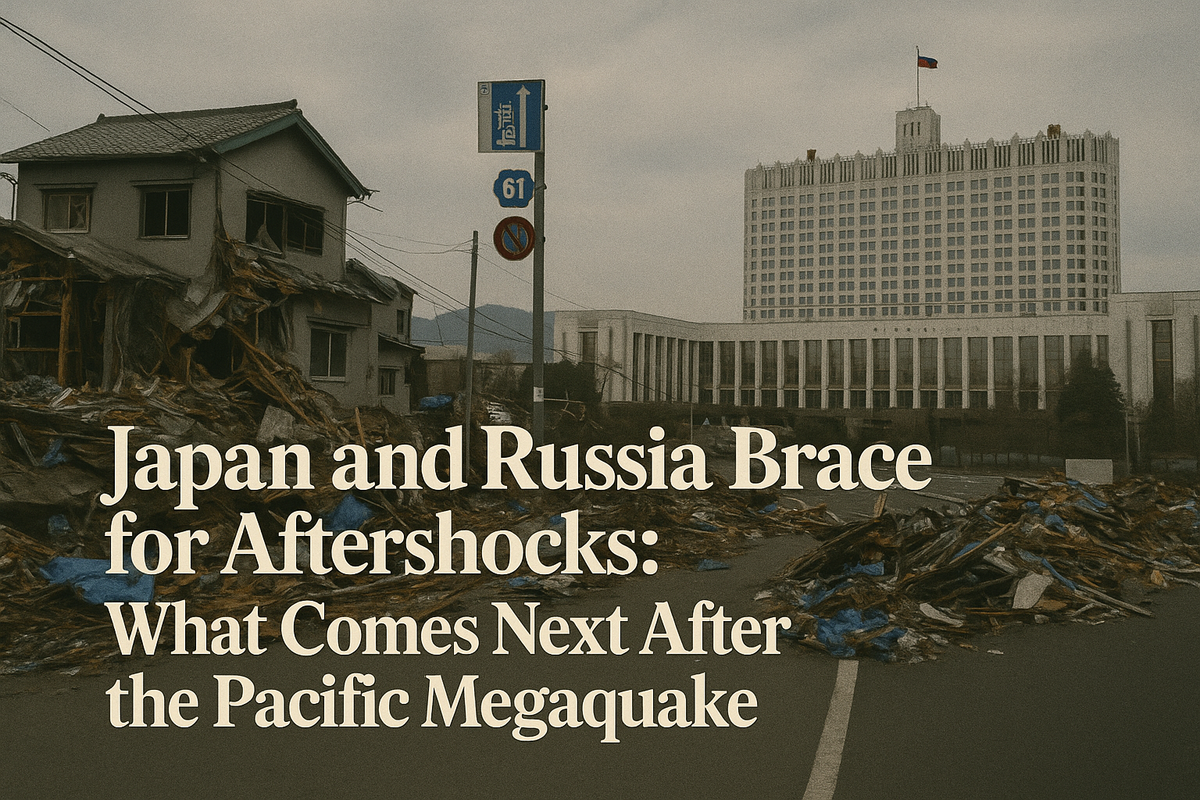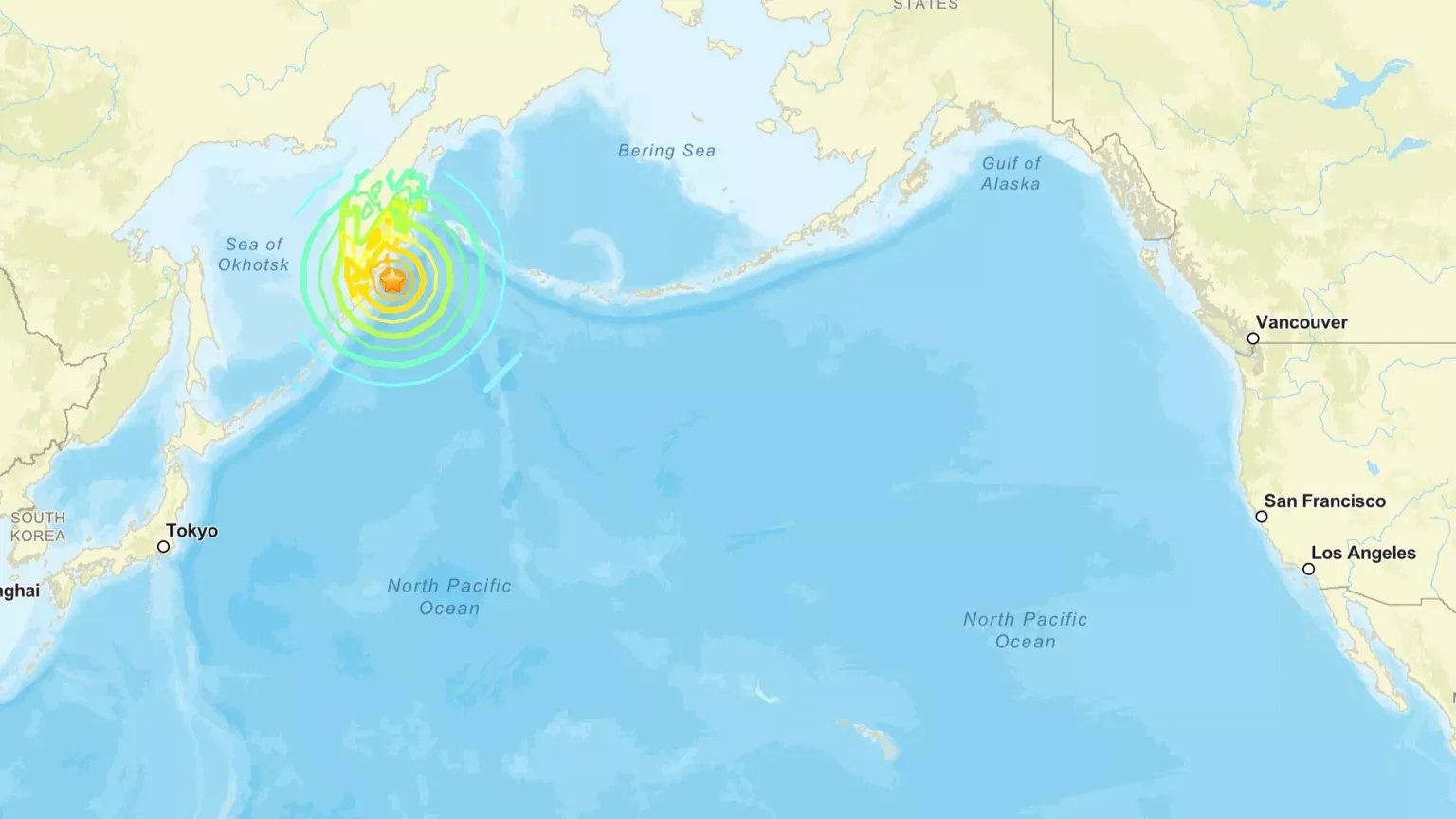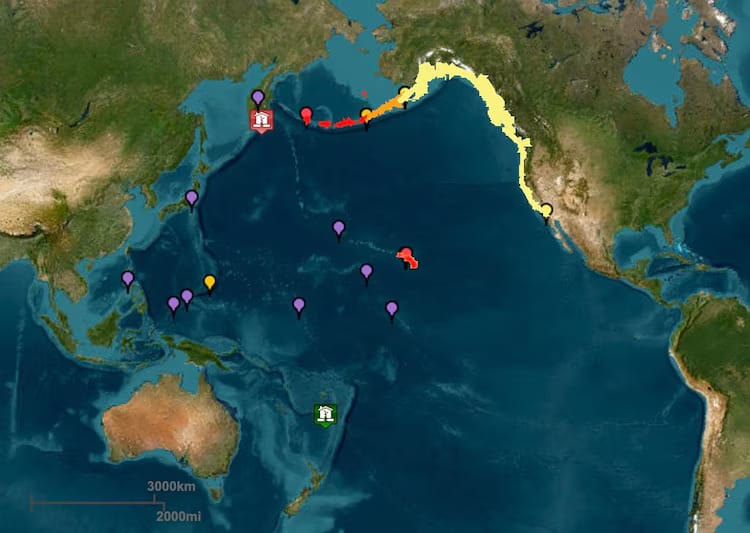Tsunami Aftershock: How the 8.8 Magnitude Quake Reshaped the Pacific Rim Overnight
A catastrophic 8.8 magnitude earthquake strikes Japan, unleashing a devastating tsunami across the Pacific Rim. This deep dive analyzes the seismic triggers, compares the Japan vs. Russia emergency response, and weighs the immense economic fallout and renewed nuclear fears on the Ring of Fire.

Written by Lavanya, Intern, Allegedly The News
TOKYO, July 30, 2025
The silence of the pre-dawn Pacific was shattered at 2:47 AM JST by a violent, low-frequency roar from deep within the Earth's crust. It began as a subtle tremor, a gentle rock that quickly escalated into a terrifying crescendo. For nearly five minutes, an eternity for those caught in its grip, a magnitude M_w 8.8 earthquake shook the northern islands of Japan. Originating from a shallow depth of just 22 kilometers along the volatile Japan Trench, it was a terrifying reminder that the planet’s most powerful forces operate on a timeline indifferent to human life. The quake itself was just the beginning; it was the titanic displacement of the seafloor that triggered the true nightmare, a massive tsunami that is, at this moment, reshaping the Pacific Rim.
Timeline of a Catastrophe
- 02:47 AM JST (T-0): The Great Quake. The magnitude 8.8 earthquake strikes, with its epicenter located approximately 95 kilometers east of Hachinohe, Japan. The prolonged, violent shaking causes immediate, severe structural damage along the northern Honshu coastline and triggers landslide warnings in mountainous regions already saturated by summer rains.
- 02:50 AM JST (T+3 Minutes): The Warning. Leveraging its dense network of seismometers that detect the faster-moving P-waves ahead of the more destructive S-waves, the Japan Meteorological Agency issues its highest-level "Major Tsunami Warning." It is broadcast on every television and radio channel via the national public broadcaster, and pushed to every cellphone in the affected regions through the Emergency Alert System. Projections warn of wave heights exceeding 10 meters. Simultaneously, the Pacific Tsunami Warning Center in Hawaii issues a Pacific-wide alert, putting nations from Russia to Chile on high alert.
- 03:22 AM JST (T+35 Minutes): First Impact. The first monstrous waves, traveling at over 800 km/h in the deep ocean, make landfall. Coastal communities in the Tōhoku region are inundated. Eerie footage shows water receding unnaturally from harbors, a tell-tale sign of a tsunami trough—before a black wall of water surges inland, its power far exceeding what many coastal defenses were designed for.
- 04:30 AM JST (T+1 Hour, 43 Minutes): Russia’s Turn. The tsunami reaches Russia’s Kuril Islands and Sakhalin Island. Emergency sirens, a legacy of Cold War-era civil defense, blare across sparsely populated towns like Yuzhno-Kurilsk as Russia's Ministry of Emergency Situations scrambles to evacuate coastal zones and secure critical energy infrastructure.
- 07:00 AM JST (T+4 Hours, 13 Minutes): A Pacific-Wide Event. The tsunami’s energy, though weakening, continues its relentless march. NOAA's Deep-ocean Assessment and Reporting of Tsunamis (DART) buoys track the waves in real-time, providing crucial data for forecasts reaching Alaska, Hawaii, and the North American West Coast in the coming hours.

The Science of Subduction: Why This Quake Was So Deadly
This catastrophe was born in a subduction zone, a place where Earth's tectonic plates collide. The epicenter was located where the massive Pacific Plate is being forced under the continental Okhotsk Plate. As the USGS explains, "megathrust earthquakes are the planet’s most powerful, occurring where one tectonic plate dives beneath another." For centuries, immense stress, the equivalent of trillions of tons of force, has been building along this fault line, a segment of the infamous Pacific Ring of Fire.
The magnitude M_w 8.8 quake was the violent release of that stress. The moment magnitude scale (M_w) is logarithmic; this event released approximately 16 times more energy than the 2010 Haiti earthquake (M_w 7.0). The fault slipped over a vast area, causing the overriding plate to lurch upwards by several meters. This vertical displacement acted like a colossal paddle, shoving a massive column of water upwards and generating the tsunami. The science is brutal: a shallow megathrust earthquake is the most efficient natural mechanism for triggering a deadly, ocean-spanning tsunami.
A Tale of Two Responses: Japan vs. Russia's Eastern Flank
The moments after the quake highlighted a stark contrast in disaster readiness between two neighboring powers.
Japan: A Nation Built for Survival
Japan’s response was a masterclass in technological integration and societal discipline, refined through bitter experience.
- Layered Defense: Japan’s strategy isn’t just about single seawalls. It is a multi-layered system: offshore detection from DART buoys and seabed sensors, rapid alerts from the JMA, immense coastal seawalls, and finally, clearly marked evacuation routes leading to reinforced vertical evacuation centers.
- Technological Integration: The response is deeply automated. Within seconds of the quake, alerts were on screen, bullet trains performed emergency stops, elevators were programmed to stop at the nearest floor, and automated valves on gas and water mains shut off to prevent secondary disasters like fires and floods.
- Citizen Readiness: The concept of tendenko, flee for your life, don't wait for others, is a harsh but life-saving cultural lesson learned from past tsunamis. This is reinforced by annual, nationwide disaster drills. Videos are already emerging of orderly, swift evacuations, a testament to decades of drills that have built muscle memory.
Russia: Centralized Might in a Vast Wilderness
Russia's Far East presents a different challenge: vast, sparsely populated territories with less advanced localized infrastructure.
- EMERCOM's Role: The response was coordinated by EMERCOM, a powerful, quasi-military ministry. Its protocols are highly effective for large-scale industrial accidents or wildfires, but are more top-down than Japan's system. Evacuation orders were broadcast via sirens and official channels, relying on regional governors to implement plans for towns scattered across the Kurils and Sakhalin Island.
- Logistical Hurdles: The sheer distance and sparse infrastructure of the region are major obstacles. Damage reports from port facilities on Sakhalin, critical for Russia's lucrative oil and gas projects and fishing villages in the Kurils, suggest a difficult and prolonged recovery. The Russian Pacific Fleet, based in Vladivostok, has been mobilized to assist in search-and-rescue and damage assessment.
- The Preparedness Gap: While Russia's system is robust, it lacks the split-second, citizen-level automation of Japan's. The effectiveness of the response relies more on the chain of command than on embedded technology and social conditioning, a crucial difference when minutes matter.

Through the Lens of Terror: Viral Videos Reveal the Scale
In the digital age, disaster is documented in real-time. Unverified videos are flooding social media, offering terrifying, ground-level perspectives. One clip from Miyako, Iwate, shows a dark wave effortlessly pushing over a 12-meter seawall, the water appearing not as liquid but as a semi-solid mass of debris, vehicles, and splintered buildings. Another, purportedly from a drone over Ofunato, captures the tsunami's inexorable advance up a river valley, flanking defenses and cutting off escape routes.
These videos are more than just morbid curiosities; they are educational tools demonstrating the horrifying physics of a tsunami. They show that the danger is not just the water, but the debris it carries, turning the wave into a horizontal grinder that no standard structure can withstand. They underscore the futility of trying to outrun or shelter in anything but designated, reinforced high-ground structures. The psychological toll of this deluge of visceral footage on both survivors and global onlookers is yet to be understood.
Economic Tsunami and the Specter of Fukushima
The human cost is still being counted, with initial reports suggesting casualties in the hundreds, potentially rising into the thousands, and tens of thousands displaced. The economic cost, according to early estimates from risk modeling firms, will certainly run into the tens of billions of dollars.
- Global Impact: As noted by sources like the following past disasters, the disruption to Japan's ports and manufacturing hubs will send ripples through global supply chains for everything from semiconductors to automobiles.
- Insurance Black Hole: Most of the losses will not be covered by private insurance. According to the Insurance Information Institute, catastrophic events like major earthquakes and tsunamis are often excluded or have very high deductibles. Governments, primarily through taxpayer funds and national debt, will bear the brunt of the rebuilding costs.
More chillingly, this event reignites the global debate over nuclear safety. The quake's epicenter was perilously close to several nuclear power plants. In a statement, Japan's Nuclear Regulation Authority confirmed that all plants in the region initiated automatic shutdowns as designed. TEPCO reported that backup systems at its facilities are "operational and stable." After the 2011 Fukushima disaster, the World Nuclear Association documented the massive safety upgrades mandated across Japan, including higher seawalls, watertight doors for critical buildings, and mobile, high-capacity backup power generators. This event is the first true, terrifying test of those multi-billion-dollar upgrades. Any failure could trigger a crisis that dwarfs the immediate physical destruction.
The Lingering Unknowns
As rescue teams navigate the wreckage, a host of critical questions emerge, the answers to which will define the long-term consequences of this disaster. Beyond the immediate death toll, what is the 'shadow toll' from disrupted medical care, psychological trauma, and long-term displacement? How will this event permanently alter global supply chains anchored in East Asia, and could it accelerate the trend of economic decoupling? Will the mass displacement of coastal populations in a developed nation like Japan finally force a global conversation on managed retreat in the face of compounding climate and seismic risks?

What Happens Next?
The immediate future is fraught with peril.
- Aftershocks: Seismologists forecast a series of powerful aftershocks, some potentially reaching magnitude 7.0 or higher, which could hamper rescue efforts, cause further damage to weakened structures, and even trigger localized tsunamis.
- International Aid: Offers of assistance are pouring in. The United States, USAID, and the presence of U.S. Forces Japan have offered full support. The International Federation of Red Cross and Red Crescent Societies (IFRC) is mobilizing to support the Japanese Red Cross.
- Geopolitical Tremors: This tragedy could become an unexpected catalyst for cooperation. Japan and Russia have a tense relationship over the disputed Kuril Islands. However, as organizations like the Council on Foreign Relations have noted, disaster diplomacy can sometimes thaw frozen conflicts. Will Russia accept Japanese aid and expertise in its affected territories? The initial signs of direct information sharing between the JMA and Russian agencies are a tentatively positive sign in a region fraught with tension.
A Test for a Modern, Brittle World
This is more than a natural disaster; it is a brutal stress test of our 21st-century civilization. It tests our most advanced technology, the resilience of our infrastructure, our societal preparedness, our globalized economy, and the safety of our most dangerous technologies. The growing vulnerability created by relentless coastal urbanization and the tight coupling of our world means the impact of such events is magnified exponentially.
The final takeaway is a sobering one. We have become masters of technology, capable of predicting a wave’s arrival down to the minute, yet we remain fundamentally powerless against the gargantuan forces that generate it. This catastrophe reminds us that preparedness and resilience are not one-time investments but a perpetual, evolving state of vigilance. It is the price of living on this dynamic, and at times, unforgivingly violent, planet.
What do you think?
Could a shared vulnerability to nature's power compel geopolitical rivals like Japan and Russia to find common ground, or will the crisis be exploited for strategic advantage?
Sources
U.S. Geological Survey (USGS), Pacific Tsunami Warning Center (PTWC), Japan Meteorological Agency (JMA), National Oceanic and Atmospheric Administration (NOAA), NHK, EMERCOM of Russia, World Nuclear Association, Japan Nuclear Regulation Authority (NRA), Reuters, Council on Foreign Relations (CFR), Verified Public Footage.




